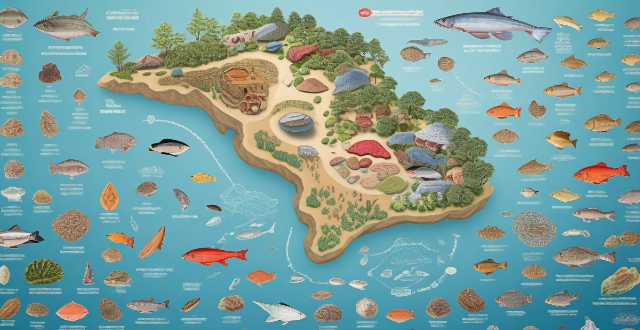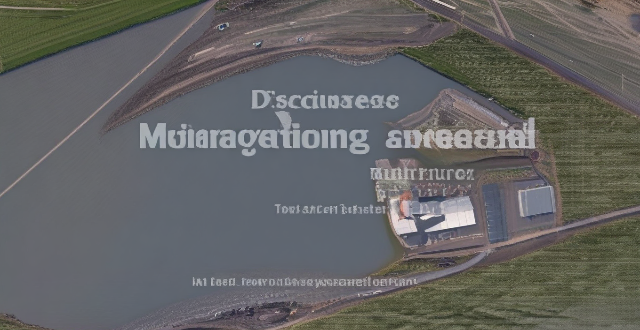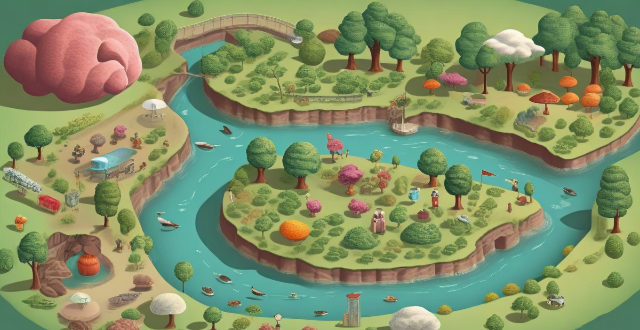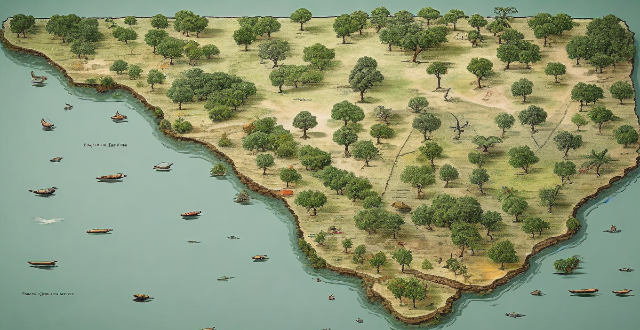Bio Genetic

What role does genetic sequencing play in virus origin tracing ?
Genetic sequencing is an essential tool for tracing the origin of viruses, particularly when it comes to identifying the source of outbreaks and understanding how they spread. By analyzing the DNA or RNA molecules present in a sample, researchers can determine its genetic makeup and compare it to known viral genomes to identify similarities and differences. This process has helped identify patterns that suggest common ancestry or recent transmission events, leading to better prevention and control measures. However, challenges such as data volume and accuracy still need to be addressed.

What is the significance of genetic diversity within biodiversity ?
Genetic diversity is a vital component of biodiversity, playing a crucial role in ecosystem health and stability. It enables species to adapt to environmental changes, resist diseases, contribute to ecosystem functioning, support food security, and provide medicinal plants. However, threats such as habitat loss, overexploitation, climate change, introduced species, and pollution pose significant risks to genetic diversity. Conservation efforts must prioritize the protection and restoration of genetic diversity to ensure the long-term survival of species and ecosystems.

How does exercise physiology explain the differences in fitness levels among individuals with different genetic backgrounds ?
Exercise physiology explores the interaction between genetic factors and environmental influences like exercise, nutrition, and sleep to explain variations in fitness levels among individuals. It examines how muscle fiber composition, cardiovascular efficiency, metabolic rate, and body composition affect one's ability to perform physical activities. While genetic background sets a baseline for fitness potential, lifestyle choices significantly impact an individual's actual fitness outcomes. By understanding these principles, individuals can optimize their fitness through targeted exercise training, proper nutrition, and adequate rest.

What is the connection between biodiversity and food security ?
The connection between biodiversity and food security is crucial, as biodiversity contributes to crop pollination, natural pest control, soil health, and genetic resources for crop improvement. Loss of biodiversity can lead to reduced crop yields, increased use of pesticides, loss of genetic diversity, and economic impacts on farmers. Sustainable agriculture practices such as agroforestry, conservation agriculture, integrated pest management, and crop rotation/intercropping can help maintain biodiversity while ensuring food security.

How does climate change affect biodiversity ?
This article explores how climate change affects biodiversity by altering ecosystems, species distribution, and genetic diversity. It discusses the impact of rising temperatures on habitat loss and altered precipitation patterns, ocean acidification on coral reefs and phytoplankton communities, and extreme weather events on fires and storms. The article also highlights the loss of genetic diversity due to reduced resilience and functional homogeneity in ecosystems, as well as inbreeding depression and genetic bottlenecks in species. Addressing climate change is essential for conserving biodiversity and maintaining healthy ecosystems.

What are the ethical implications of genetically modified organisms (GMOs) on the environment ?
The article discusses the ethical implications of genetically modified organisms (GMOs) on the environment, including their potential impact on biodiversity, risk of environmental disasters, and broader economic and social implications. It highlights concerns such as loss of native species due to competition for resources, genetic contamination, and habitat destruction; the potential spread of pests and diseases, ecosystem disruption, and genetic pollution; as well as issues related to monopolies and access to seeds, dependence on corporations, and loss of autonomy for farmers. The conclusion emphasizes the importance of considering these ethical considerations in decisions regarding the development and deployment of GMOs to prevent irreparable harm to ecosystems and communities.

What are the ethical considerations surrounding the use of technology in sports, such as performance-enhancing drugs or genetic testing ?
The use of technology in sports raises numerous ethical considerations, particularly when it comes to performance-enhancing drugs and genetic testing. These technological advancements can significantly impact fairness, integrity, and the very essence of athletic competition. In this discussion, we will explore the various ethical issues surrounding these technologies and their implications for sports. One of the primary ethical concerns with PEDs is the issue of fairness and equity. Athletes who use PEDs gain an unfair advantage over those who do not, as they can enhance their physical abilities beyond what is achievable through natural means. This undermines the fundamental principle of sports, which is to showcase one's talent and hard work through fair competition. Another ethical consideration is the potential health risks associated with PEDs. Many of these substances can have severe side effects and long-term consequences on athletes' health. The pressure to perform at the highest level can lead athletes to take unnecessary risks with their well-being, raising questions about the moral responsibility of sports organizations and governing bodies to protect their athletes. The use of PEDs also threatens the integrity of competition. If some athletes are using PEDs while others are not, it creates an uneven playing field that undermines the legitimacy of the sport and its outcomes. Additionally, the widespread use of PEDs could lead to a culture where cheating becomes normalized, further eroding the values and principles upon which sports are built. Genetic testing raises significant ethical concerns regarding privacy and consent. Athletes may be required to undergo genetic testing to determine their susceptibility to certain conditions or to identify potential performance advantages. However, this practice raises questions about whether athletes fully understand the implications of such testing and whether they are truly giving informed consent. Genetic testing also has the potential to lead to discrimination and stigmatization based on an athlete's genetic makeup. If certain genetic traits are deemed advantageous or disadvantageous, it could result in unfair treatment or exclusion from competition. This raises concerns about the potential misuse of genetic information and the need for strict regulations to prevent discrimination. Finally, genetic testing presents moral dilemmas related to the concept of "designer babies" and gene editing. If parents choose to select or modify their children's genes to give them a competitive edge in sports, it raises complex ethical questions about the role of nature versus nurture in athletic success and the potential consequences of creating a generation of genetically enhanced athletes. In conclusion, the use of technology in sports, particularly performance-enhancing drugs and genetic testing, raises numerous ethical considerations related to fairness, equity, health risks, integrity of competition, privacy, consent, discrimination, and moral dilemmas. As technology continues to advance, it is essential for sports organizations and governing bodies to address these ethical issues proactively and establish strict regulations to ensure the integrity and fairness of athletic competition.

What are some emerging trends in the field of energy storage materials research ?
The text discusses the latest trends in energy storage materials research, focusing on solid-state batteries, flow batteries, metal-air batteries, supercapacitors, redox flow batteries, hybrid energy storage systems, nanostructured materials, smart grid integration, thermal energy storage, and organic/bio-based materials. Each section provides a brief overview of the technology's advantages and current research challenges.

How much does it cost to obtain a tourist visa ?
This detailed guide outlines the cost implications and requirements for obtaining a tourist visa to the People's Republic of China as of July 2024, using the process in the United States as an example. The guide covers visa types, required documents, additional requirements, cost implications, and the application procedure. It also highlights recent simplifications in the document requirements and emphasizes the importance of meeting all specified requirements and being prepared for associated costs.

What role do protected areas play in conserving biodiversity in a changing climate ?
The text discusses the importance of protected areas in maintaining biodiversity and mitigating climate change impacts. It highlights their role as safe havens for endangered species, genetic diversity repositories, and carbon sinks. Protected areas also serve as research hubs, offering data on climate change effects and experimental zones. Strategies to enhance their effectiveness include expansion, management reinforcement, community involvement, and sustainable funding. These areas are crucial in conserving biodiversity and adapting to climate change, ensuring the survival of species and preservation of ecological balance.

How does deforestation contribute to both climate change and biodiversity loss ?
The text discusses the impact of deforestation on climate change and biodiversity loss. It explains how trees act as carbon sinks, absorbing CO2 from the atmosphere during photosynthesis, but when forests are cleared, this process is halted, and the stored carbon is released back into the atmosphere as CO2. Deforestation also involves burning trees, which releases other greenhouse gases like methane and nitrous oxide, contributing to global warming. The text further explains how forests provide habitat for countless species of animals, insects, and plants, but clearing forests destroys these habitats, leading to a loss of biodiversity. Even partial deforestation can fragment habitats, isolating populations and reducing genetic diversity. Without tree roots to hold soil together, erosion increases, affecting water quality and availability, which can further impact species that depend on specific water sources or soil types. The text concludes that deforestation is a complex issue with far-reaching consequences for both climate change and biodiversity loss, requiring a multifaceted approach that considers both environmental protection and human needs.

What policies and international agreements aim to address the dual crises of climate change and biodiversity loss ?
The text discusses various policies and international agreements aimed at addressing climate change and biodiversity loss. These include the Paris Agreement, Convention on Biological Diversity (CBD), Aichi Biodiversity Targets, United Nations Sustainable Development Goals (SDGs), Ramsar Convention on Wetlands, and International Union for Conservation of Nature (IUCN) Red List of Threatened Species. The text emphasizes the interconnectedness of these issues and the need for collaborative efforts to achieve a sustainable future.

What is biodiversity and why is it important ?
Biodiversity is the variety of life on Earth, including ecosystems, species, and genetic variation within species. It plays a vital role in supporting ecosystem services, ensuring food security, providing medicinal resources, enriching cultural heritage, and enhancing resilience to environmental changes. The loss of biodiversity can lead to reduced ecosystem function, increased vulnerability, economic impact, and loss of future options. Protecting biodiversity involves habitat protection, sustainable use, legislative measures, public awareness, and research and monitoring. Conserving biodiversity is essential for maintaining the balance of ecosystems and ensuring that future generations can enjoy the benefits provided by the variety of life on Earth.

How do invasive species affect biodiversity ?
Invasive species can have a significant impact on native biodiversity, both positively and negatively. They can outcompete and replace native species, leading to changes in community structure and ecosystem function. Invasive species can also cause damage to infrastructure and human health through the spread of disease or destruction of habitats. Management strategies for invasive species include prevention measures such as quarantines and biosecurity protocols, as well as control measures such as eradication programs and habitat restoration. It is important to consider the costs and benefits of each strategy when developing a management plan.

What is the impact of climate change on biodiversity and conservation law ?
Climate change is a significant threat to biodiversity, affecting species distribution, abundance, and behavior. This has implications for conservation law, which aims to protect and manage biodiversity. The impact of climate change on biodiversity includes habitat loss and fragmentation, altered ecosystem functioning, and increased risk of species extinction. Conservation law must evolve to address these challenges, incorporating resilience measures into conservation strategies and fostering collaboration across sectors. By taking a proactive approach, we can help ensure that future generations continue to benefit from the diverse array of species and ecosystems that make up our planet's natural heritage.

How do urban greening projects affect biodiversity in cities ?
Urban greening projects, which aim to increase the amount of vegetation within cities, can have significant effects on urban biodiversity. These projects typically involve planting trees, creating parks and green spaces, and restoring natural habitats. Here are some ways in which these initiatives can influence the variety of species living in urban areas: - Increased Habitat Availability: By adding more greenery, urban greening provides additional habitats for a wide range of organisms. This includes plants, insects, birds, and small mammals that can thrive in these newly created environments. - Mitigation of Urban Heat Islands: Vegetation helps reduce the urban heat island effect by providing shade and releasing water through transpiration, creating cooler microclimates that are more suitable for certain species. - Enhanced Food Sources: Flowering plants attract pollinators like bees and butterflies, supporting their populations and contributing to the health of the overall ecosystem. - Increased Water Quality and Availability: Green roofs and rain gardens help manage stormwater runoff, reducing pollution and providing water sources for urban wildlife. - Promotion of Biodiversity through Education and Awareness: Parks and green spaces serve as outdoor classrooms, offering opportunities for education about ecology and conservation. While urban greening projects offer numerous benefits for biodiversity, they also present challenges such as potential introduction of invasive species, maintenance requirements, and resource allocation trade-offs with other land uses.

What is the relationship between biodiversity and traditional knowledge ?
The text discusses the complex interrelationship between biodiversity and traditional knowledge, highlighting how each influences and shapes the other in various ways. It explains that communities living in diverse ecosystems develop unique practices adapted to their surroundings, such as specific crop rotations or intercropping methods suited to local biodiversity. The availability of certain species also influences dietary habits, with coastal communities relying heavily on seafood while inland communities depend more on terrestrial resources. Furthermore, high biodiversity regions often lead to extensive knowledge about medicinal plants, with Indigenous communities having long histories of using local flora for healing. The need for sustainable harvesting of these plants can lead to traditional conservation practices like rotating harvest areas or planting more of certain species to ensure their survival. On the other hand, traditional knowledge often includes practices for managing resources sustainably, such as fishing techniques that do not deplete fish populations or agricultural methods that maintain soil fertility. In many cultures, certain areas are considered sacred and are protected from exploitation, serving as de facto conservation reserves. However, as biodiversity declines, so does the traditional knowledge associated with it. The loss of certain species can lead to the disappearance of associated cultural practices and knowledge. With diminished biodiversity, traditional knowledge becomes less effective, leaving communities vulnerable to ecological shifts. In conclusion, the relationship between biodiversity and traditional knowledge is one of mutual dependence and influence. While biodiversity shapes the development of traditional knowledge, this knowledge also plays a critical role in maintaining and conserving biodiversity. Preserving both is essential for the well-being of our planet and its people.

How do celebrities manage their online presence and reputation on social media ?
Celebrities manage their online presence and reputation on social media by hiring a social media manager, maintaining consistency across platforms, engaging with fans, promoting positive messages, handling criticism gracefully, and monitoring their image. These strategies help them maintain a positive online presence while connecting with fans and promoting their work effectively.

Is it possible for a virus to have multiple origins ?
Viruses are elusive entities with complex evolutionary histories, and understanding their origins is crucial for public health and disease control. While traditional theories suggest singular origins for viruses, evidence supports the possibility of multiple origins through processes like recombination, host switching, environmental influences, zoonotic events, genetic exchange with host cells, ancient viral lineages, and laboratory manipulation. Recognizing these complexities is essential for advancing scientific knowledge, improving public health outcomes, and enhancing our ability to respond to emerging infectious diseases.

How can we trace the origin of a virus ?
This article explores the methodologies and techniques used to trace the origins of viral outbreaks, using examples such as MERS-CoV, SARS-CoV-2, and other significant viruses. It discusses epidemiological investigations, genetic sequencing and analysis, ecological investigations, molecular clock analysis, and viral culture and isolation as key approaches in this process. By combining these methods, scientists can build a comprehensive picture of a virus's origins, which is vital for preventing future outbreaks and developing effective treatments and vaccines.

What are the latest trends in sports research and development ?
The latest trends in sports research and development include wearable technology for real-time monitoring, data analytics for performance evaluation, genetic testing for personalized training, VR and AR for skill development, recovery technologies like cryotherapy, and nutritional advances. These advancements focus on enhancing athletic performance while emphasizing athlete health and well-being.

How do ecological protection areas contribute to biodiversity conservation ?
Ecological protection areas contribute significantly to the conservation of biodiversity by preserving habitats, protecting endangered species, maintaining genetic diversity, mitigating climate change, and promoting education and awareness. These areas are crucial for the long-term survival of ecosystems and the diverse range of species that depend on them.

How do celebrities establish and maintain a successful personal brand ?
Celebrities establish and maintain a successful personal brand by defining their brand persona, building a strong online presence, being consistent in messaging and imagery, networking and collaborating with others, staying true to themselves, and continuously learning and evolving. A strong personal brand helps celebrities stand out in their industry and build a loyal fan base.

What policies and international agreements aim to protect biodiversity ?
The text provides an overview of various policies and international agreements that aim to protect biodiversity, including the Convention on Biological Diversity (CBD), the United Nations Framework Convention on Climate Change (UNFCCC), the Ramsar Convention, the International Union for Conservation of Nature (IUCN), the World Wildlife Fund (WWF), the Nagoya Protocol, the Global Environment Facility (GEF), national policies and legislation, and the Great Ape Project. These initiatives are crucial for maintaining ecosystem health and human well-being, but face challenges in implementation and enforcement.

How can advancements in technology aid in more accurate virus origin tracing ?
The article discusses the role of technology in tracing virus origins, highlighting various techniques such as genomic sequencing, phylogenetic analysis, data mining, machine learning, satellite imagery, and remote sensing. These methods provide powerful tools for understanding how viruses evolve and spread over time, as well as identifying areas at risk for future outbreaks. The advancements in technology have revolutionized our ability to trace the origins of viruses, offering valuable insights into the ecological factors that contribute to virus emergence.